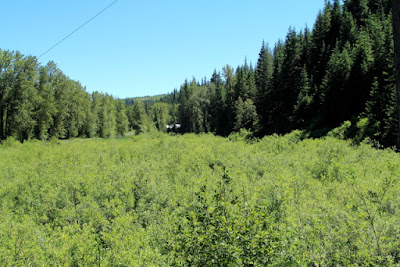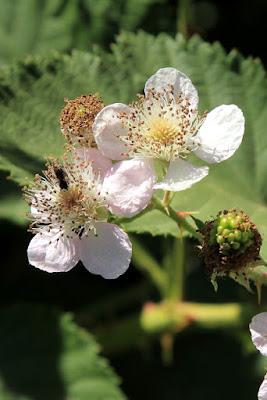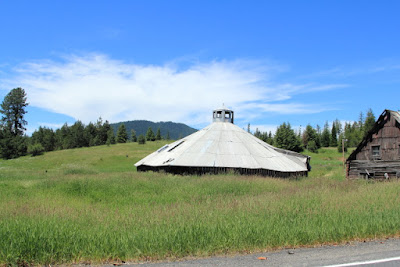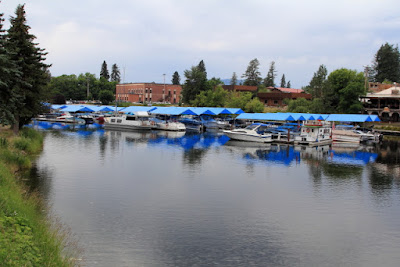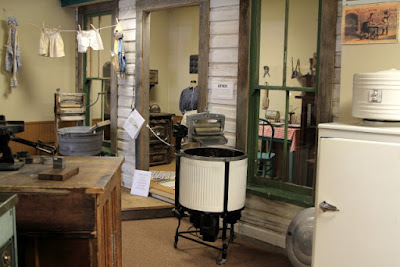Friday, August 25, 2017
RonnieAdventure #0270 - Northern Idaho (2017)
From Orofino followed Grangemont Road up to Old Pierce, the place "Where Idaho First Began."
Pierce was thought to be the first town in present-day Idaho and was picked to be the Washington Territory Shoshone County seat in 1861. (At that time, Shoshone County included most of present-day Wyoming.) A courthouse was constructed in 1862 and is considered to be Idaho's oldest public building still standing. [Researchers have now concluded that Franklin (located in southeast Idaho) was settled several months earlier than Pierce, but at that time the territory had not been surveyed and everyone, including the residents, thought Franklin was located in Utah Territory.]
Although gold lured miners to the Pierce area in 1860, it was the timber industry that made many men rich. Exhibits at the J. Howard Bradbury Logging Museum include early horse logging equipment, an extensive chainsaw collection, a flag with 48 stars (the number of states when I was in school), and a really old "Snow Traveler."
The general store in Pierce is an interesting stop for anything that you may need (department store, hunting/fishing equipment, liquor store, hardware store, lumber yard, etc).They also have on display the "World's Largest Bear Trap" that is 63 inches long and weighs 138 pounds. The building also houses a large collection of trophy animals.
Two miles down the road from Pierce is the site of Oro Fino, which had "about sixty houses; nine or ten stores, more saloons than are needed, two smith-shops, two butcher shops, three families and about five hundred inhabitants." The town burned to the ground on August 10, 1867 and was never rebuilt.
In 1885 five Chinese men were charged with killing a local merchant, so the the deputy sheriff and several men were assigned to transport the prisoners to Murray for trial. However, just past the old townsite of Oro Fino a group of masked vigilantes forced the deputy sheriff to turn over the Chinese prisoners and return to Pierce. The vigilantes then hung all five of the Chinese prisoners. Today there is a footpath leading from the highway to a marker located in the forest where the hanging occurred.
Weippe is the location where Lewis and Clark made first contact with the Nez Perce on September 20, 1805. Clark recorded in his journal: "...at a distance of 1 mile from the lodges I met three boys... they ran and hid themselves... [I] search and found 2 of the boys... gave them small pieces of ribin & sent them forward to the village... a man came out to meet me, (with great caution)... & conducted me to a large spacious lodge which he told me (by signs) was the lodge of his great chief... gave us a small piece of buffalow meat, some dried salmon berries & roots... which they call Pas Seh Co (quamash)." Clark then "...collected a horse load of roots & 3 sammon" to send back to the main expedition.
The Weippe Hilltop Heritage Museum has been constructed near the place where the village was located.
The Dworshak Dam (located to the west of Orofino) is the third highest dam in the United States and the tallest straight-axis concrete gravity dam in North America. It is 717 feet high, 0.75 miles long, contains 7.5 miles of tunnels and 4.5 miles of stairways. The reservoir behind the dam is 54 miles long and has a storage capacity of 3,468,000 acre-feet of water.
In May of 1980 a 200-foot crack opened in the dam dike and 6,000 gallons of water per minuted flowed into the tunnels and entered the powerhouse. Pumps were set up to drain accumulating water in the tunnels and then a slurry mixture of concrete, volcanic ash, and other materials was pumped down the reservoir side of the dam. As the mixture was starting to set, a pump failed, so the workers began pouring slurry over the side of the dam using 5-gallon buckets. The water pressure in the reservoir forced the mixture into the crack, which significantly slowed the leak. Using grout to fill the crack from the inside, the crew further slow the leak, but they could not stop the leak completely. Engineers concluded that it would be unsafe to try any further fixes, so permanent pipes were installed in the tunnels and now drain off about 370 gallons of water per minute that still flows through the crack.
About two miles downstream from the dam, the North Fork Clearwater River joins the Clearwater river at Ahsahka. This was the site of the Nez Perce village that Lewis and Clark called Canoe Camp because they camped at this location for 11 days in 1805 and and the Nez Perce showed them how to built five canoes for their journey to the pacific.
Juliaetta (population 579) was originally named Schupferville, but in 1882 the postmaster changed the town's name to Juliaetta to honor his two daughters Julia and Etta.
Like many parts of rural Idaho, small towns are struggling to keep businesses in their downtown areas; so buildings are often reconfigured for alternate uses. In Juliaetta a garage has become a restaurant called "Bottom's Up" and the historic bank building has become "1st Bank of Pizza."
Clarkia (population 50) is a small but interesting place. It is one of only two places in the world (the other is in India) where star garnets are found. And as a bonus, Fossil Bowl is open to the public where they can dig for fossils for free.
Approaching Clarkia I had a really bad felling when I noticed that the Fossil Bowl was completely filled with RVs and motorcycles were everywhere. Stopping at the general store/gas station/bar/restaurant/hunting & fishing supply store, and other uses, the owner informed that I picked the wrong weekend to be in Clarkia because they were using the Fossil Bowl for a motocross track with a creek jump that is over an actual creek. They were also having a hill climb (called Devil's Drop).
The road to the garnet beds (8 miles away) was reported to be in poor condition, so we had a sandwich in the restaurant and enjoyed some of the races.
A few miles south of St. Maries (on the west side of Highway 3) there was a really strange looking building with a round roof. I don't think that I have ever seen a similar building.
In St. Maries I found myself in front of the Courthouse when I wasn't planning to be. Realizing that I must have taken a wrong turn, I was studying a map when a man on an ATV drove up and asked me if I was lost. I explained that I wasn't "lost," but I apparently missed Highway 3 somewhere in town. He said the intersection was confusing and I needed to backtrack two traffic lights, which I did and found Highway 3.
About seven miles out of town there was a historic marker by the side of the road explaining that the Saint Joseph Indian Mission had originally been just to the west of the sign (on the shore of Lake Coeur d'alene); but the area was a large swamp and kept flooding, so the Mission was moved to Cataldo in 1846.
Just up the road there was a Mullan Road historical marker at the junction of State Highways 3 and 97 explaining that in 1859, "Swamps in the St. Joe Valley had to be corduroyed with logs, and 70 men spent a week digging out sidehills south of here and chopping through 3 miles of forest. But after all that work, spring floods made this route impossible. Two years later, Mullan had to survey and build a new section of his road around the north of Coeur d'Alene Lake."
Just outside of Cataldo we found Old Mission State Park (aka Mission of the Sacred Heart or Cataldo Mission), which contains the original church, a parish house, and a modern visitor center. The church was constructed between 1850 and 1853 and is the oldest standing building in Idaho.
The Cedar Street Bridge in Sandpoint is the longest retail bridge in the world (It spans Sand Creek.). There are also a number of eating establishments on the bridge.
Just down Sand Creek is the marina and City Beach.
We left our trailer in Sagle and decided to take a day trip down US Highway 95. First stop was in Cocolalla at the Wolf People Store where they sell "Wolfabilia." Since they were having a sale, we were going to purchase something for Lisa; but the store was closed. The wolf viewing area was also closed. Sorry Lisa!
Next stop was the traffic signal at the intersection of Lancaster Road and US Highway 95. Although we were stopped at the intersection, the truck behind us didn't. Next stop was the Emergency Room at Kootenai Health Care Facility in Coeur d'Alene.
After spending all afternoon in the emergency room, we were released with stiff necks and sore backs. Our vehicle was still derivable, but not in any condition to pull a trailer, so we decided to leave the trailer in Sagle and drive home to recover from the accident and have our pickup repaired.
(I knew I should have left more pennies on that alley wall in Mountain Home for good luck!)
Friday, August 18, 2017
RonnieAdventure #0269 - Western Idaho (2017)
Traveling north from Boise on State Highway 55 we arrived at the Splash Dams on the North Fork of the Payette River. Splash Dams were used to store logs in the early 1900s until the logs could be moved downstream to the mills in Horseshoe Bend and Emmett.
During the winter months, trees were cut and the logs held in the dams until spring when the ice melted and the logs could be moved to the mills. A historic marker on the side of the highway indicated that in 1904 the water was treacherous and only half of the logs made it to the mills. Four lumberjacks lost their lives during that log drive.
There is a historical marker in Cascade indicating that in 1878 (about a mile north of the sign) four men were ambushed by Indians while trying to recover stolen horses. Three of the men were killed immediately; but "Three Finger" Smith, "being a man of experience in such maters," fled southward and found the cavalry. Smith estimated that they were ambushed by at least 75 Indians; but when the cavalry arrived at the site, the Army trackers determined that there had only been 5 Indians (and the Indians were never caught).
In 1905 the town of Roseberry was growing and had a hotel, two black smith shops, two stores, two churches, a restaurant, law office, school, bank, doctor's office, butcher shop, logging mill, and a creamery. It was destined to be the largest town in Long Valley. However in 1914, the railroad bypassed Roseberry by two miles, so almost everyone relocated to an area near the railroad tracks to the west. Many of the buildings were moved on skids and the new town was called Donnelly. Roseberry became a ghost town and is now protected by the Long Valley Preservation Society, Idaho Heritage Trust, and other donors.
At the entrance to the campground where we were staying in McCall, there was on old Army aircraft parked by the side of the road. The wings had been removed and were on the ground in front of the aircraft. It was unclear why it was parked there. Maybe someone was going to restore it.
One evening it was still light after dinner, so we followed a backroad around Payette Lake (about 20 miles). This was a beautiful drive and the road ran next to the lake in most places.
New Meadows is located at the junction of Highways US 95 and State Route 55 and considers itself to be "The Center of Idaho Heart Land."
Parker John's Cabin is located just north of New Meadows and is a famous Idaho historic Landmark. A roadside marker states: "Territorial political conventions (Republican in 1863 and Democratic in 1864) used this facility as a point where North Idaho leaders could meet with southern representatives to choose congressional candidates." The site is now a state park with a campground located along a small stream.
A few miles north of the junction we crossed the 45th Parallel. (A point halfway between the Equator and the North Pole.)
The one bad thing about pulling a trailer is that you can not always stop or turnaround when you want to take a picture. Just before we entered Riggins was one of those times.
Riggins is a small town not close to anything and when I came over a hill on the outskirts of town, I thought I was in downtown Los Angeles. There were cars, pickups, campers, and people everywhere. After driving through the small community I found a place to pull over and I walked back to a gas station to find out what was happening - Salmon fishing season! But what was so strange is that all of the fishermen were crowded into one small section of the Salmon River and no one was fishing on the other side of town where I parked.
After leaving Riggins on US Highway 95 there were signs of historic hydraulic mining on the west bank of the river. A historical marker by the side of the highway stated that Hydraulic mining "shot powerful streams of water against a pre-historic river bed (now the bank of the stream) to expose and wash down gold-bearing gravel, which then was sluiced to recover the gold." Unfortunately, it left ugly scars on the landscape!
US Highway 95 runs through the Salmon River Canyon that was carved about 15 million years ago when the mountains were rising and the river eroded into the older rock below. This is a beautiful drive because the road follows the river through the canyon. Unfortunately there were not a lot of stopping places when you are pulling a trailer and the existing pullouts were typically on the wrong side of the road.
The road up White Bird Grade was one of the more difficult grades that I have done since Alaska. I had to downshift to second gear and go about 35 mph just to keep the transmission temperature from going into the red zone. Anyway, near the top of the grade there is a turnout and observation area for the White Bird Battlefield (Nez Perce National Historical Park).
This battle was the start of the Nez Perce War when over 100 cavalrymen charged a band of about 60 Indians down a ravine in order to stop them from crossing the river. The Indians wiped out a third of the cavalry, forcing them to retreat, and no Indians were killed during the battle.
Grangeville is the largest city, and the county seat, in Idaho County. This is a popular tourist destination and we have camped in Grangevill before at a beautiful campground just outside of town.
People like to vacation in the Grangevill area because this is where the Camas Prairie meet the Nez Perce National Forest, Grangeville is the Nez Perce name Sike-sike, meaning "the foot of the mountain."
Traveling north on Idaho State Highway 13 the road parallels the Clearwater River and passes through the community of Harpster (now just a few scattered houses and buldings). However, during the mining boom Harpster had a hotel, livery barn, harness shop, four saloons, two general stores, drug store, and a blacksmith shop.
Kooskia is located up the road from Harpster at the confluence of the South and Middle forks of the Clearwater River, which was the location of the Chief Looking Glass Village and his band of Nez Perce. The Nez Perce word koos-koos-kia refers to the Clearwater River, "the lesser of the two large rivers in the vicinity, the other being the Snake."
During WW II the Kooskia Internment Camp was located about 30 miles northeast of town and was so remote that fences and guard towers were unnecessary. Apparently, there is nothing left at the Internment Camp site.
Just south of modern day Kamiah is the location of the 1806 Lewis and Clark Long Camp where the Corps of Discovery waited six weeks for the snow to melt from the high ridges of the Lolo Trail. [It is now possible to follow the Lolo Trail over the Bitterroot Mountains from the Weippe Prairie (Idaho) to the Bitterroot Valley (Montana) along a single-lane dirt trail without services - a high-clearance 4WD vehicle is recommended.]
Orofino is located on the east side of the Clearwater River at the junction of Highways US 12 and Michigan Avenue (Grangemont Road) and has a really nice campground that runs along the east side of the river. There are flowers, metal sculptures, and there is a nice old grain elevator is just downstream from the bridge!
During the winter months, trees were cut and the logs held in the dams until spring when the ice melted and the logs could be moved to the mills. A historic marker on the side of the highway indicated that in 1904 the water was treacherous and only half of the logs made it to the mills. Four lumberjacks lost their lives during that log drive.
There is a historical marker in Cascade indicating that in 1878 (about a mile north of the sign) four men were ambushed by Indians while trying to recover stolen horses. Three of the men were killed immediately; but "Three Finger" Smith, "being a man of experience in such maters," fled southward and found the cavalry. Smith estimated that they were ambushed by at least 75 Indians; but when the cavalry arrived at the site, the Army trackers determined that there had only been 5 Indians (and the Indians were never caught).
 |
| This is what happens when you have wrong camera settings |
At the entrance to the campground where we were staying in McCall, there was on old Army aircraft parked by the side of the road. The wings had been removed and were on the ground in front of the aircraft. It was unclear why it was parked there. Maybe someone was going to restore it.
One evening it was still light after dinner, so we followed a backroad around Payette Lake (about 20 miles). This was a beautiful drive and the road ran next to the lake in most places.
New Meadows is located at the junction of Highways US 95 and State Route 55 and considers itself to be "The Center of Idaho Heart Land."
Parker John's Cabin is located just north of New Meadows and is a famous Idaho historic Landmark. A roadside marker states: "Territorial political conventions (Republican in 1863 and Democratic in 1864) used this facility as a point where North Idaho leaders could meet with southern representatives to choose congressional candidates." The site is now a state park with a campground located along a small stream.
A few miles north of the junction we crossed the 45th Parallel. (A point halfway between the Equator and the North Pole.)
The one bad thing about pulling a trailer is that you can not always stop or turnaround when you want to take a picture. Just before we entered Riggins was one of those times.
Riggins is a small town not close to anything and when I came over a hill on the outskirts of town, I thought I was in downtown Los Angeles. There were cars, pickups, campers, and people everywhere. After driving through the small community I found a place to pull over and I walked back to a gas station to find out what was happening - Salmon fishing season! But what was so strange is that all of the fishermen were crowded into one small section of the Salmon River and no one was fishing on the other side of town where I parked.
After leaving Riggins on US Highway 95 there were signs of historic hydraulic mining on the west bank of the river. A historical marker by the side of the highway stated that Hydraulic mining "shot powerful streams of water against a pre-historic river bed (now the bank of the stream) to expose and wash down gold-bearing gravel, which then was sluiced to recover the gold." Unfortunately, it left ugly scars on the landscape!
US Highway 95 runs through the Salmon River Canyon that was carved about 15 million years ago when the mountains were rising and the river eroded into the older rock below. This is a beautiful drive because the road follows the river through the canyon. Unfortunately there were not a lot of stopping places when you are pulling a trailer and the existing pullouts were typically on the wrong side of the road.
The road up White Bird Grade was one of the more difficult grades that I have done since Alaska. I had to downshift to second gear and go about 35 mph just to keep the transmission temperature from going into the red zone. Anyway, near the top of the grade there is a turnout and observation area for the White Bird Battlefield (Nez Perce National Historical Park).
This battle was the start of the Nez Perce War when over 100 cavalrymen charged a band of about 60 Indians down a ravine in order to stop them from crossing the river. The Indians wiped out a third of the cavalry, forcing them to retreat, and no Indians were killed during the battle.
Grangeville is the largest city, and the county seat, in Idaho County. This is a popular tourist destination and we have camped in Grangevill before at a beautiful campground just outside of town.
People like to vacation in the Grangevill area because this is where the Camas Prairie meet the Nez Perce National Forest, Grangeville is the Nez Perce name Sike-sike, meaning "the foot of the mountain."
Traveling north on Idaho State Highway 13 the road parallels the Clearwater River and passes through the community of Harpster (now just a few scattered houses and buldings). However, during the mining boom Harpster had a hotel, livery barn, harness shop, four saloons, two general stores, drug store, and a blacksmith shop.
Kooskia is located up the road from Harpster at the confluence of the South and Middle forks of the Clearwater River, which was the location of the Chief Looking Glass Village and his band of Nez Perce. The Nez Perce word koos-koos-kia refers to the Clearwater River, "the lesser of the two large rivers in the vicinity, the other being the Snake."
During WW II the Kooskia Internment Camp was located about 30 miles northeast of town and was so remote that fences and guard towers were unnecessary. Apparently, there is nothing left at the Internment Camp site.
Just south of modern day Kamiah is the location of the 1806 Lewis and Clark Long Camp where the Corps of Discovery waited six weeks for the snow to melt from the high ridges of the Lolo Trail. [It is now possible to follow the Lolo Trail over the Bitterroot Mountains from the Weippe Prairie (Idaho) to the Bitterroot Valley (Montana) along a single-lane dirt trail without services - a high-clearance 4WD vehicle is recommended.]
Orofino is located on the east side of the Clearwater River at the junction of Highways US 12 and Michigan Avenue (Grangemont Road) and has a really nice campground that runs along the east side of the river. There are flowers, metal sculptures, and there is a nice old grain elevator is just downstream from the bridge!
Subscribe to:
Posts (Atom)













